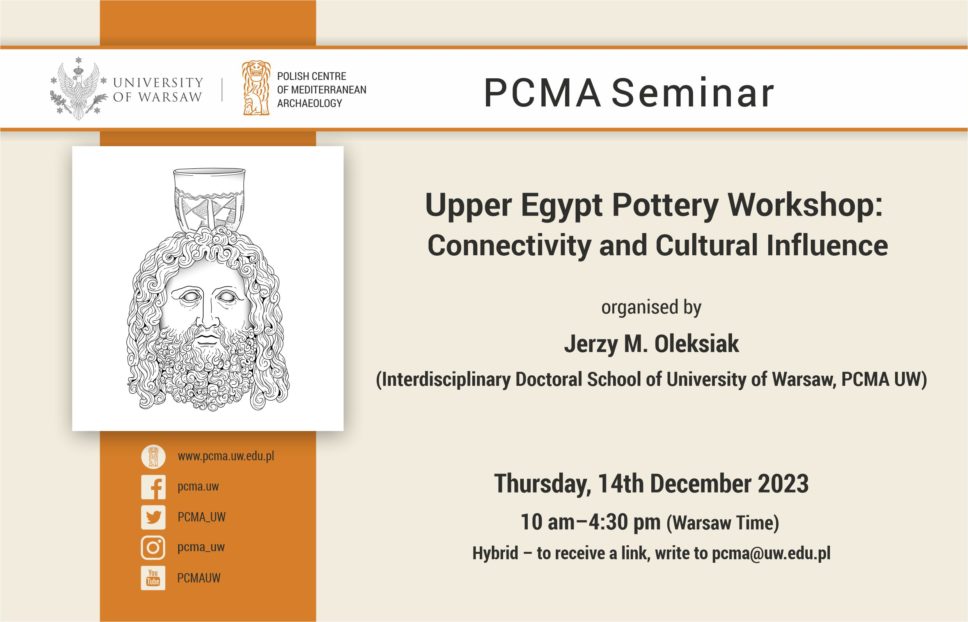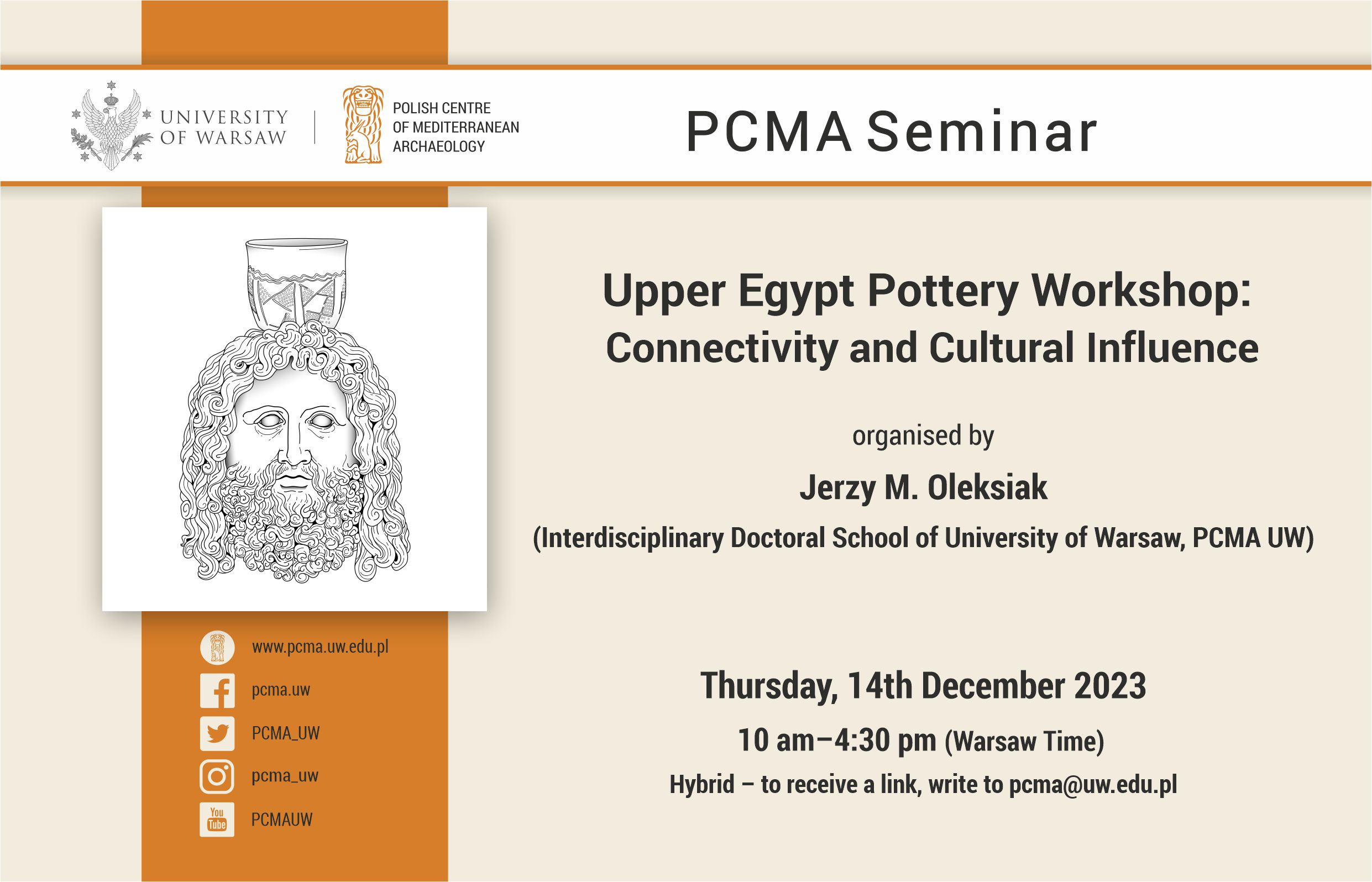Kolejne z grudniowych Seminariów PCMA będzie gościć całodniowe warsztaty poświęcone badaniom zespołów ceramicznych w południowym Egipcie i północnej Nubii. Organizatorem spotkania o tytule „Upper Egypt Pottery Workshop – Connectivity and Cultural Influence” jest Jerzy M. Oleksiak (Międzydziedzinowa Szkoła Doktorska i Centrum Archeologii Śródziemnomorskiej Uniwersytetu Warszawskiego).
Tematyka warsztatów skupia się na badaniach ceramiki z terenów Tebaidy, Pustyni Wschodniej i Zachodniej oraz strefy granicznej między Górnym Egiptem a Dolną Nubią od okresu hellenistycznego do późnego antyku (od III wieku p.n.e. do VII wieku n.e.). Spotkanie ma na celu zebranie międzynarodowej grupy badaczy, którzy podzielą się swoją wiedzą na temat rezultatów wykopalisk i pozyskanych z nich zespołów ceramicznych w południowym Egipcie i północnej Nubii – od zachodniej części pustyni do wybrzeża Morza Czerwonego.
Pierwsza połowa spotkania poświęcona jest omówieniu głównych zagadnień związanych z tym regionem w starożytności: korelacjom, stosunkom gospodarczym, wpływom kulturowym i politycznym, czy zmianom chronologicznym. W tej części prelegenci wygłoszą referaty na temat zespołów garncarskich z Syene, oazy Kharga, Deir el-Atrash i pogranicza egipsko-nubijskiego. Druga połowa ma na celu przedstawienie aspektów metodologicznych, które są kluczowe dla obecnego stanu wiedzy w zakresie badań nad ceramiką. W jej trakcie zaprezentowane zostaną dane ceramiczne z Syene, Berenike, Senskis i Teb Zachodnich. Całe wydarzenie zakończy się dyskusją na temat przyszłych badań i współpracy w Górnym Egipcie.
Warsztaty odbędą się w formie hybrydowej, w siedzibie CAŚ UW i online. Można w nich wziąć udział zdalnie. Aby otrzymać link, prosimy o napisanie maila na adres: pcma@uw.edu.pl
Program: PDF
ABSTRAKTY WYSTĄPIEŃ:
- (godz. 10:15–10:40) Mariola Hepa, Ludwig-Maximilians-Universität München
„Guardhouse or the place of cultic activities? The in situ inventory of a room in Ptolemaic Syene.”
Abstrakt: „From the Ptolemaic Period onwards, Syene (modern Aswan) became the centre of the cluster of settlements at the First Cataract and thus outranked the old capital Elephantine. Archaeological evidence shows that there was very little settlement activity during the Early Ptolemaic Period. Projects such as the construction of the Temple of Isis under Ptolemy III seem to have been isolated efforts with little effect on the settlement as a whole. The situation changed completely from the reigns of Ptolemy VI/VIII onwards. Then, the town wall from the Late Period was partly destroyed and the town swiftly extended beyond its former limits. There is little evidence for the ethnic composition of Ptolemaic Syene. Several inscriptions show that the town – as befits a garrison – housed a multicultural population.
Area 2 is located in the south-eastern part of Syene. In it, the south-eastern corner of the Late Period town wall is preserved. The area is separated from Area 1 and the Temple of Isis by a modern four-lane road. The small building (Building 7) was located in the southern section of the town wall thus just outside the urban area. The in situ assemblage of pottery and other finds found in this building is unique for Syene. This paper presents the function of Building 7 based both on mobile and immobile elements (installations) of its inventory. The fact that the building was only in use for a short period of time makes the objects sealed by the collapse of the building important for the refinement of the chronological pottery sequence of Hellenistic Syene. A coin from layers connected to the construction and first use of the wall gave a terminus post quem for its construction in the reign of Ptolemy VI/VIII or later.”
- (godz. 10:40–11:05) Clementina Caputo, Politecnico di Milano, Department Architecture, Built Environment and Construction engineering (DABC); Julie Marchand, Université Libre de Bruxelles (ULB) & Royal Museums of Art and History (KMKG- MRAH)
„From East to West: Exchange and trade patterns from Late Roman to early Islamic Egypt on both sides of the Nile Valley.”
Abstrakt: „In the scientific literature, the Egyptian deserts are often described in contrast with one another, one compared to a scatter of islands and the other as a hostile space that must be crossed to reach the Red Sea. Yet they are comparable spaces, governed by parallel economies. In this paper, the authors, a specialist in the Western Desert (CC) and one in the Eastern Desert (JM), will compare the networks and mechanisms of economic exchange between these two areas, with the Nile Valley and neighbouring regions between the late Roman and early Islamic periods.
Are the ceramic products found on either side of the Nile valley comparable? Do the distribution networks mirror each other? How did they evolve over the longue durée? How do these remote regions fit into the great Mediterranean trade networks? What are the starting points on the Egyptian territory for these distribution networks? Are the desert sites their final destinations or an intermediate step towards somewhere else?”
- (godz. 11:05–11:30) Katarzyna de Lellis-Danys, PCMA University of Warsaw, National Museum in Warsaw
„Connectivity of the Upper Egypt with the Middle Nile Valley in the Light of the 6th–7th century CE Ceramics.”
Abstrakt: „The paper aims to present the connectivity of Upper Egypt with the Middle Nile Valley, evidenced by the pottery finds. The proposed timeframes encompassed the crucial period for Nubia – the arrival and establishment of a new faith, Christianity. Although the missionaries came from Constantinople and not from Egypt, possibly the Middle Nile Valley and neighbouring Upper Egypt shared more connectivities based on daily life. The arrival of Christianity brought Nubia a “Byzantine package”, including administrative and cultural changes, which also affected the pottery production. The paper aims to present these aspects and seek evidence of reversed interactions from the Middle Nile Valley to Upper Egypt.”
- (godz. 12:15–12:40) Laura Rembart, Austrian Archaeological Institute of the Austrian Academy of Sciences
„Material culture in Upper Egypt. Studies on the ceramic find material from Syene and Elephantine.”
Abstrakt: „The Upper Egyptian city of Syene, modern Aswan, and the neighbouring Nile island of Elephantine were an economic and political centre in antiquity and formed an important link between Egypt and Nubia to the south. Both cities functioned as a trading hub for exchanging goods to and from Inner Africa. As the southernmost city of the Ptolemaic and later the Roman Empire, Syene also had an administrative and military role. With the development of new clay deposits, a large pottery centre arose in the Aswan area in the 2nd century BCE, whose products made from the so-called Aswan Pink Clay were very popular and exported throughout Egypt from the early imperial period onwards. At least for the late antiquity, an export beyond the borders is proven. The position as a trading city is also reflected in the local pottery production and the Mediterranean influences that can be noticed. The Aswan Pink Clay – a clay paste, visually appearing in a pinkish colour and being associated to kaolinite was probably mined at many different extraction sites. Petrographic analyses made it possible to distinguish four different clay pastes. Since, so far, no archaeological evidence for larger workshops in the vicinity of Aswan does exist, the question of a pottery production centre must remain open.
In order to better understand the local ceramic production, its export radius, and the definition of local traditions and foreign influences, the ceramic find material from PtolemaicRoman Syene and late antique Elephantine in combination with natural science methods and a geological survey of the wider area was examined and analysed within the FWF project “Housing in Antiquity in Syene/Elephantine, Upper Egypt.”
- (godz. 12:45–13:15) Roderick C.A. Geerts, Faculty of Archaeology, Leiden University; Nicholas Bartos, Department of Classics and Archaeology Center, Stanford University
„Toward a Regional Comparison of Pottery Assemblages in Roman Egypt: A Field Methodology at the Red Sea Port of Berenike.”
Abstrakt: „In recent decades, archaeologists have increasingly employed large, quantified datasets to investigate historical patterns at the regional level. Ceramics are especially useful given their relative ubiquity, preservation, and utility as chronological and spatial markers. Yet, assessments of ancient social and economic trends at a regional scale are hindered to a certain degree by inconsistencies in field methodologies and publication standards across different archaeological projects. Pottery studies in Roman Egypt have traditionally been slow to adapt to newer trends. Since the 1980s, the rise in excavation of Roman sites in Egypt has significantly advanced our knowledge, but more scholarship featuring quantified assemblages and detailed attention to typology, form, and fabric analyses is necessary to contextualize the Egyptian material within the rest of the Roman world.
In the spirit of this collaborative workshop, this paper outlines the full field methodology currently used during ongoing excavation at the Red Sea port of Berenike, with the twofold goals of inspiring parallel practice at other sites and inviting critique for more efficient and comparable data processing at Berenike itself. Following a description of the field practice at Berenike – from preliminary sorting, database structure, and analysis – we present a case study on the Early Roman and Late Antique transport vessel assemblage to highlight the potential of this approach.
We then prompt several possible complications of the methodology and the study of ceramics in Roman Egypt more broadly. We suggest that only by being explicit about our field methodologies at regular intervals prior to publication can we hope to collectively pursue regional comparisons of pottery assemblages across Roman Egypt and illuminate the socioeconomic dynamics of this important province at a higher resolution.”
- (godz. 13:15–13:40) Jerzy M. Oleksiak, Interdisciplinary Doctoral School of University of Warsaw, PCMA University of Warsaw
„Refining the Late Antique chronology. Full quantification and class-division methods as a key to Berenike and Senskis phasing.”
Abstrakt: „Mass pottery material collected from the last five years of excavation in the Eastern Desert sites of Berenike and Sikait provides broad and diverse evidence. Together with well-stratified loci from all types of structures in both sites, it is possible to gain a deeper insight into the distribution, typology of transport and common ware material, and chronology of loci previously seen as homogenous Late Antique layers (from the 4th to the late 6th century AD). With the use of full quantification and class-division methods and more than 70,000 sherds gathered from both archaeological sites, it is now possible to distinguish phases more precisely and, furthermore, to outline chronological trends in the influx of imported wares from the Red Sea, Nile Valley and Eastern Mediterranean.”
- (godz. 13:40–14:05) Aleksandra Pawlikowska-Gwiazda, National Museum in Warsaw
„Monastic Pottery in Western Thebes: The Case of St. Phoibammon Monastery.”
Abstrakt: „Western Thebes, a region in Upper Egypt, has captivated the interest of travellers and scientists for centuries. Situated on the left bank of the Nile, opposite Luxor, this area has served as both a necropolis and a place of worship over the centuries. Its peak of human activity occurred during the New Kingdom period when monumental temples, such as the funerary temple of Hatshepsut, and the tombs of officials were erected. Additionally, the tombs of officials surrounded these temples. The function of this locale underwent a significant transformation with the arrival of Christian anchorites in the 5th centuries CE. The Theban necropolis, once a city of the dead, evolved into a city of monks. Tombs were repurposed into hermitages, gradually expanding into larger monastic complexes.
The purpose of this paper is to present the findings of my PhD dissertation titled ‚The Material Culture of Monks in Western Thebes from the 4th to the 10th century AD.’ The primary focus will be on pottery discoveries, leading to a broader discussion of pottery production in Western Thebes. Moreover, the Monastery of St. Phoibammon, along with other monastic sites, will be regarded as part of a wider monastic network involved in interregional pottery trade.”
Warsztaty zostały zorganizowane w ramach projektu Jerzego M. Oleksiaka pt. „By dotrzeć na wschód, płyń na południe – Berenike i Morze Czerwone jako główny aktor wymiany ekonomicznej Oceanu Indyjskiego w późnym antyku” finansowanego z grantu Narodowego Centrum Nauki Preludium 21, 2022/45/N/HS3/01784.
Więcej na temat projektu: link


